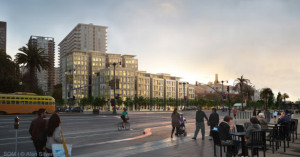Last week I went to the Principals’ Roundtable sponsored by furniture dealer SideMark in the beautiful all-white Teknion showroom high up in 88 Kearny. The speaker was the director of city planning, John Rahaim. He was informal, accessible, friendly, but not slick. He doesn’t have the Gavin Newsom charm, smile, or hair.
I am the kind of person who is apt to see most struggles through class lenses. And while this kind of conflict may have been true in the past, I think it is less and less true in the gentrified city. The narratives are more nuanced.One of the things that Rahaim said was that since the passage of the 1985 downtown plan, the focus of downtown development has been largely South of Market, and most of the development battles are now in the neighborhoods. (555 Washington Street, next to the Transamerica Pyramid, is a recent exception.) In other words, they are low stakes. He also said that a lot of these battles were class-based, especially in the Mission District, where he lives.
 |
| Marxist Lenses |
Let’s take last week’s planning hearing for 8 Washington. Some folks tried to suggest that it was a case of condos for the wealthy versus an almost-public pool and tennis club. But that’s not true. It was a case of a relatively expensive private tennis and swim club versus the folks slightly higher up on the food chain, i.e. the lower end of the one percent. (The really rich aren’t leaving outer Broadway.)
 |
| Eight Washington Street courtesy som.com |
More and more planning battles are between different strands of the middle class. The North Beach branch library fight was highly politicized, but what was it really about? While the original architects, Appleton & Wolford, designed some competent mid-century work, this branch was, by far, their least significant work.
The fight wasn’t really about preserving mid-century architecture. It was about the ability to wage a public fight in a highly participatory political environment (created by district elections). The proposed library by Leddy Maytum Stacy Architects provides more accessible space and closes off a small portion of street, a generally sustainable idea. (Given the rancor from the opposition, it’s amazing that the North Beach Pool ever got renovated!) I think the larger narrative in what I call “tiny turf land use wars” is actually an existential response to the Internet age.
The Internet and all these blogs (including mine I suppose!) make us feel smaller and smaller, while at the same time offering each of us an opportunity to have our say and maybe get a second of recognition. Although planning hearings can go on for hours (that feel like days to the participants), it is the Internet that helps create the frame. The blogosphere gets the turnout and generates the buzz that the Bay Guardian used to.
 |
| North Beach Library courtesy lmsarch.com |
What’s happening in San Francisco is the collapse of the far left because they can’t afford to live here anymore. That is not to say that several cranky types who bought early, have an independent income, or are protected by rent control won’t be staying on and sending out missives on an hourly basis. Join the fun!
The class-based narrative is the easiest one to grab—branded, as it were. My first participation in a planning battle was the downzoning of Nob Hill in the late 1970s. This was when there were still Republicans on the board of supervisors! A group of middle- and working-class neighbors came together under the umbrella of something called the Nob Hill Neighbors to fight for open space and against new high-rise development.
To be honest, there were a few parcels on Jones Street along the crest and one along Sacramento that could have handled high-rises without disrupting the quality of life while following the excellent principles put forth in Allan Jacobs’s urban design plan. But you know, young Marxists don’t give developers an inch.…
I wondered how this ragtag band of neighbors was going to fight the wealthy interests and the more conservative neighborhood group, the Nob Hill Association. This was a narrative that would be repeated several times in the coming decades—the upper class aligning with the working class to meet their own objectives. (Think Warren Hellman.) Our side’s rich benefactor owned one of the penthouses at 1170 Sacramento and didn’t want his view blocked. And he paid for a lobbyist who got the ear of the conservative supervisor Quentin Kopp, who switched to our side.
 |
| The owner of one of the penthouses aligned with his poorer neighbors to stop more high-rises. |
About ten years ago, I got drawn into a tiny turf land use battle. A carpenter and two architects wanted to save a piece of significant mid-century architecture, the Daphne Funeral Home at One Church Street, designed by A. Quincy Jones. Bridge Housing, an admirable nonprofit housing developer, thought the move to save the building was just an effort by NIMBYs trying to block a new project for low-income people. In other words, a classic class confrontation.
Bridge misread the narrative. Indeed it was a left-leaning motley group of folks, including some prescient mid-century preservationists and low-income neighbors, who wanted to save a piece of history, albeit modern history. Bridge’s misjudgment resulted in long delays to their project. Design writers from all over the country started to cover the story, and later a resurgence of interest in Jones’s work took place. Even the estimable former UC Berkeley College of Environmental Design dean Richard Bender took a swipe at Jones during a public hearing, saying something to the effect that “he was no Richard Neutra.”
The reappraisal of Jones and the recent reopening of Sunnylands in Palm Springs prove Bender and Bridge were both wrong. What was really happening was that the same classes were fighting each other over their perception of what San Francisco needed. The middle- and upper-middle-class employees of Bridge were fighting on behalf of low-income residents, while a group of middle- and upper- middle-class architects, historians, and design writers, led by a working-class carpenter, were fighting for preservation and open space. And both groups were right. San Francisco needed more low-income housing, and San Francisco needed to respect its modernist heritage as much as any other.
 |
| Daphne Funeral Home by A. Quincy Jones photo: Donna Kempner |
During that particular battle, a few of us called for Bridge to explore the design ideas that Jones had originally employed (even if some of them were auto-centric) and use the best ones to develop a scheme that related to nature, which was his great accomplishment. But the Bridge design was set, and we all got an ugly, cheap historicist building that probably won’t last three decades. (Interestingly, Bridge finally got on the quality architecture bandwagon and hired the same architect who designed the new North Beach library.)
The point here is that we should probably admit that in San Francisco, gentrification has, with the exception of Hunters Point and Bayview, pretty much happened. The narratives underlying most of the development battles are not off-the-shelf rich versus poor. The development fights are now mostly among various members of the upper-middle classes. But each one has a different flavor. Some are worth fighting, but many are a waste of the city’s resources.
I am getting less tolerant of rich folks suing each other over their views and fear of diminishing entitlement. Perhaps they should look for a deeper narrative, blog about it, let it go, and advocate for taxing themselves. Think Warren Buffet.
 |
| Buffet Lenses |
